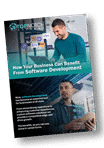Software development can be crucial for business growth, and it’s common for many businesses to demand processes that offer flexibility and structure.
The most favored methodologies include Agile, Waterfall, and Hybrid, with each providing a distinct approach to managing projects. While Agile supports quick updates and rapid responses, Waterfall follows a clear sequential plan for projects with well-defined requirements, and Hybrid blends these methods to balance flexibility with structure.
By the end of this post, you will understand the benefits of each approach and best use cases, and discover how selecting the correct methodology can improve project outcomes.

Table Of Contents
Overview of Software Development Methodologies
Software projects benefit from a transparent process that guides planning, execution, and delivery. Selecting the appropriate methodology can influence project timelines, team coordination, and overall success.
- Agile. The Agile methodology centers on breaking projects into small and manageable parts delivered in short cycles. It promotes regular feedback and ongoing adjustments to meet emerging requirements.
- Waterfall. The Waterfall methodology follows a linear sequence, with each phase requiring completion before proceeding to the next. This method works best when project requirements are stable and clearly defined.
- Hybrid. The Hybrid methodology blends elements of both approaches, allowing teams to benefit from structured planning while retaining the ability to respond to changes.
Selecting the right methodology is critical. The chosen approach shapes task organization, change management, and progress tracking. Aligning the method with project goals can lead to better resource allocation and smoother execution, ensuring that deliverables meet quality standards and you get them on schedule.

Relevance for Businesses
Businesses from across sectors often operate in competitive environments, and project demands tend to vary.
- Agile methods help teams react quickly when requirements change or new priorities emerge.
- Waterfall offers a systematic process for projects with fixed goals and predictable outcomes.
- Hybrid approaches provide the flexibility to incorporate both structured phases and responsive adjustments.
Many businesses/organizations must balance a strict plan with the ability to adapt. The appropriate methodology can improve team collaboration, streamline decision-making, and support efficient resource management. By choosing a method that fits specific project needs, businesses can enhance productivity and drive better results in software development.
Agile Methodology
The Agile methodology follows a flexible approach that divides projects into smaller segments, allowing teams to deliver working software in short cycles. This method supports frequent review and adjustment, ensuring that the final product meets business requirements. In addition, Agile encourages open communication and teamwork throughout the project lifecycle, fostering an environment where it’s easy to address changes promptly.
Key Principles and Benefits
Agile relies on a cycle of repeated development phases that provide multiple opportunities for review and feedback. Regular meetings and updates keep all stakeholders informed, ensuring that a project aligns with desired outcomes.
One of the main benefits is rapid delivery, which allows businesses to see tangible results early in the process. This method also makes it easier to incorporate new changes or adjust priorities as a project progresses, reducing the risk of delays or misalignment with business goals.
By breaking work into smaller tasks, teams can quickly identify and resolve issues, contributing to higher product quality. In addition, the emphasis on collaboration helps create a shared understanding of project objectives, leading to more efficient workflows and better overall performance.
Best Use Cases
Agile is particularly effective for projects with frequently changing requirements and where customer input is critical to success. Software development teams that work on web applications, mobile apps, and/or digital platforms often see significant benefits from Agile practices.
This approach works well in industries facing rapid technological or market demand shifts, such as technology startups and digital marketing agencies. Projects that require continuous improvement and regular updates benefit from Agile’s flexible nature, which allows teams to adapt quickly as conditions change.
Agile is ideal for businesses/organizations prioritizing fast delivery and responsiveness to client needs. It provides the structure needed to manage complex projects while making room for creative problem-solving.
Waterfall Methodology
The Waterfall methodology follows a traditional step-by-step approach to business software development that emphasizes careful planning and sequential execution. This method organizes work into distinct stages, requiring the completion of each phase before you can get to the next. Its clear structure and detailed documentation offer a reliable process for managing projects with fixed requirements.
Process Flow and Characteristics
The Waterfall process begins with requirement gathering, and involves recording all project goals and specifications in detail. This phase establishes a project’s foundation by setting clear objectives and deliverables.
System design takes place next, which includes planning the technical architecture and creating design documents. Development begins once these are in place by creating code according to design specifications.
A project moves into testing after coding, during which developers rigorously evaluate the software against established requirements. Finally, a project enters deployment, releasing the software into the production environment. Ongoing maintenance to address issues and ensure smooth operation is a must.
This method’s sequential nature allows teams to focus on one phase at a time, minimizing the risk of overlooking critical details. Clear documentation at every step provides a valuable record of decisions and changes, making it easier to manage a project from start to finish.
With each stage building on the work completed in the previous phase, the Waterfall approach delivers a predictable process that can simplify project tracking and timeline management.
When to Use Waterfall
Waterfall is best suited for projects with well-defined, unlikely-to-change requirements. It is particularly effective when a linear and methodical approach is necessary to meet strict regulatory or quality standards.
For instance, projects such as government contracts, enterprise system upgrades, or infrastructure developments often require a clear plan and detailed documentation. These projects benefit from a structured process that minimizes uncertainty and keeps them on schedule.

The Hybrid Software Development Methodology
Hybrid methodologies offer a balanced approach by combining the strengths of Agile and Waterfall. This method leverages Waterfall’s precise and sequential planning with Agile’s flexibility and rapid feedback cycles. By blending Agile and Waterfall, teams can enjoy a structured process that accommodates necessary changes as projects evolve.
Combining Agile and Waterfall
Hybrid approaches combine Waterfall’s detailed planning and documentation characteristics with responsive short-cycle development in Agile. In the early stages, projects follow a clear, step-by-step plan where requirements are gathered and documented thoroughly. This provides a solid basis for a project, while establishing key milestones and deliverables.
Software developers rely on Agile practices to break down tasks into manageable segments as a project progresses. Regular check-ins, short development cycles, and continuous feedback sessions allow teams to adjust to new information or changing priorities.
Combined Waterfall and Agile software development methodologies offer the discipline of a linear process while allowing teams to tweak or enhance features during development. This flexibility gives developers the ability to resolve unexpected challenges or opportunities without disrupting project timelines.
Why Would You Want to Blend Agile and Waterfall Approaches?
The primary advantage of combining Waterfall and Agile and following a Hybrid approach is that it gives you the ability to work with a controlled structure while leaving room for adaptability. For instance, projects with well-defined elements, such as regulatory requirements or fixed client expectations, benefit from the upfront planning and strict documentation of Waterfall.
On the other hand, you can manage components that require frequent updates or benefit from customer feedback using Agile’s iterative methods. Hybrid Agile methodologies support efficient resource allocation by clearly outlining tasks in the early phases and then allowing adjustments as work progresses.
In addition, while Hybrid Agile development helps reduce risks by ensuring the planning and execution of critical steps in sequence, it maintains the flexibility to incorporate improvements based on real-time feedback.
A Hybrid Agile and Waterfall methodology is typically well-suited for projects where some areas are fixed and others are open to change, making it ideal for complex software development. This balanced approach enhances project predictability while ensuring that the final product remains aligned with evolving business needs, ultimately leading to improved outcomes and client satisfaction.
Looking to Create a Marketing Strategy?Request a Quote
Selecting the Right Methodology
Determining if you should combine Waterfall and Agile or choose just one of them is essential for project success. The right approach can streamline processes, mitigate risks, and align outcomes with business goals.
Decision Factors and Project Requirements
Several factors guide the decision-making process when selecting a methodology, and you must pay attention to each.
- Project size. The size of a project matters because larger projects may require detailed planning and formal documentation, while smaller initiatives benefit from flexible and rapid cycles.
- Complexity. Accounting for the complexity of your project is important because projects with many interdependent components need a structured process to ensure accurate delivery.
- Risk assessment. Assessing risk is crucial, too. Projects with higher uncertainty benefit from a method that allows for regular reviews and adjustments.
- Stakeholder involvement. The degree of stakeholder involvement and the frequency of required feedback should have a bearing on your choice.
- Existing practices. You should also consider a method’s alignment with existing team practices and organizational culture.
Once you evaluate these factors, you’ll find it easier to select the most suitable approach for meeting specific project needs.
Comparing Methodologies With Business Goals
Agile, Waterfall, and Hybrid methodologies serve varied business objectives, and you must compare all before arriving at a decision.
- Agile. Agile suits projects where requirements may shift and there’s a need for quick delivery. Its approach of breaking work into short cycles allows teams to adjust as priorities change.
- Waterfall. With its sequential stage-by-stage process, Waterfall works best when requirements are precise and stable. Its systematic nature provides clarity and thorough documentation, making progress easier to track.
- Hybrid. An Agile and Waterfall combined approach blends elements of both, offering structure where necessary while allowing for flexibility where changes occur. This balance is ideal for projects that contain predictable and uncertain elements.

Why Hire a Software Development Company
If you partner with a reputable and experienced software development company, you can be sure that it has a firm grip on Agile, Waterfall, and Hybrid methodologies. In addition, it would already have handled projects across various sectors, consistently providing solutions that align with different operational needs.
The best in the business apply tested methods to manage projects efficiently, ensuring precise execution of every stage, from planning to maintenance. Their approach emphasizes thorough documentation and careful planning, which minimizes risks and supports smooth project execution.
Client Success Stories and Proven Results
Previous work of the company you select should have resulted in measurable improvements for its clients. For example, if a project involved a mid-sized enterprise that needed a cloud-based solution to streamline its operations, the resultant software should have delivered enhanced performance and improved data accessibility, leading to faster decision-making and lower overhead costs.
Client testimonials should speak about a software development company’s ability to deliver solutions that meet and exceed expectations. Elements you should look for include clear communication, attention to detail, and commitment to quality.
Keep in mind that successful project outcomes and positive client feedback highlight a software development company’s capability to handle complex challenges and build software that drives tangible results.
Conclusion
Understanding the strengths of Agile, Waterfall, and Hybrid approaches helps businesses select the methodology that suits their project size, complexity, and risk the best. Choosing the right method can improve efficiency and better align with business goals. For example, it could be a good idea to combine Waterfall and Agile if you’re requirement involves strong structure coupled with some flexibility.
Whether you need an Agile-Waterfall Hybrid project plan or one that relies on a single methodology, keep in mind that creating any type of business software requires extensive knowledge that extends beyond coding. As a result, if you need custom software for your business, partnering with a reputable software development company is the ideal way forward. It can also guide you on which methodology would work best for your project.





